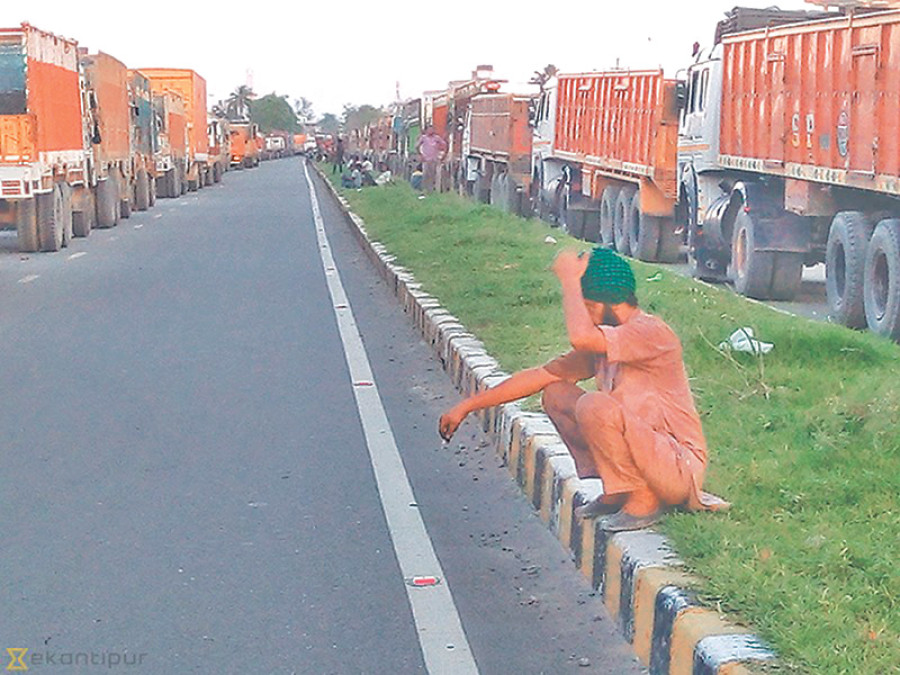Opinion
Keep calm and trade on
What effects the introduction of GST in India will have on Nepal remains to be seen
Samridhi Pant
Nepal’s economy cannot remain untouched from the Goods and Services Tax (GST) launched in India last July. The general impact of GST would be an upsurge in inflation in the short term, but a structured and prosperous economy in the long run. While India leaps to reap the benefits of GST, Nepal needs to understand how the country’s economy can cope with the short- and long-term effects that the tax will bring forth. The immediate effect of GST on goods coming into Nepal is already visible in the form of long queues of cargo trucks at the border. The delay in clearance has been blamed on the upgradation of information technology systems at Indian customs offices.
Reading the fine print
Further, third country imports through India has also become dearer, but this has been attributed to cargo handling costs rather than the cost of goods. Nepali importers and exporters have to pay 18 percent service charge on all operations at Kolkata port, which was 15 percent prior to GST. Similarly, on the export side, the port authority of Kolkata has started to impose a 5 percent service charge on Nepali exports to third countries. This will make Nepali products expensive in the international market. The Nepal-India trade and transit treaty says that Nepal will get a free transit route as it is a landlocked country, but it also says that ‘there shall be reasonable charges for transportation and other services rendered for the supervision of such transit’.
Nepal conducts 65 percent of its total trade with India, and this does not include the informal trade that happens between the two countries. The open border between India and Nepal is considered to be a major reason for the huge volume of informal trade. Implementation of GST will bring this unorganised trade under the organised sector, boosting trade between the two countries. The GST single taxation system will also eliminate the ripple effects of central and state level taxes on imports from India which will have a positive impact on Nepal’s overall trade with the southern neighbour.
Nepal can also benefit from lower taxes on products like fertilisers. However, with regard to its exports, lower prices of food commodities in India, including tea, sugar and other agro products, and other essential goods which have been put at the lower end of the tax slab of 5 percent will erode the competitiveness of Nepali goods sold in India. Also, informal exports of Nepali goods to India could increase since such informal trade is not recorded by the government and hence is not taxed.
When the road is long
The overall impact of GST on Nepal will be challenging if proper policy measures are not taken. Although GST is a consumer tax in India, Nepal has reason for concern as the cost of transit facilities will make third country imports and exports more expensive. Exporters and importers of landlocked countries usually face high logistic costs mainly due to low logistics reliability and predictability. Infrastructure improvement and supply chain efficiency will definitely aid in minimising the additional costs incurred by Nepal on the movement of goods.
On the import side, Nepal has constantly been facing problems regarding stranded containers at Kolkata port due to poor railway infrastructure, the latest being the damage caused to one of the railway tracks linking Sirsiya dry port in Birgunj and Kolkata port last March.
Such problems add to the cost of traders which ultimately makes goods dearer when they reach Nepal. On the export side, the small market for Nepali goods in third countries prevents price benefits from being reflected in the costs incurred. Also, where trade volumes are low, transit logistics are usually prone to rent seeking.
It is yet to be seen how Nepal’s economy will react to the implementation of GST in India, but it should start working on reevaluating policies that will boost healthy trade between the two countries. High transport and transit costs can be tackled by making bilateral efforts for trade facilitation, improving cross-border logistics, boosting regional transport and ICT connectivity and ensuring consistent upgradation of transport corridors with adequate investment. Such changes face many hurdles because many people extract rent from the current system. However, streamlining the import-export process could lower costs, besides increasing predictability, reliability and investment.
Pant has a master’s degree from Nanyang Technological University, Singapore




 18.12°C Kathmandu
18.12°C Kathmandu










